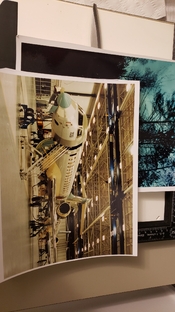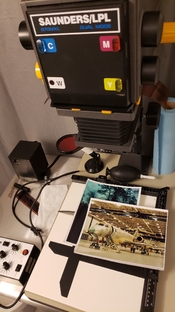can I simply pour out a bit of my old solution and simply pour the same amount of the fresh solution?
Yes, that's the idea. Usually you lose some of the developer anyway due to carry-over into subsequent baths; some of it soaks into the emulsion and sticks to the paper. It makes sense to periodically measure the volume of your developer and take into account the attrition rate as you replenish.
For instance, you may start out with 1000ml of developer at the start of a session.
After 20 sheets or so, you measure the volume again and find there's only 940ml left, so you lost 60ml due to carryover.
Based on the paper usage, you may want to replenish 100ml, but since you've already lost 60ml in carryover, you only need to discard an additional 40ml from the 940ml volume. Then you add 100ml fresh replenisher.
If this is the case, can you also use the same technique for C-41 chemistry?
I suppose so, but to be frank, I'm don't really trust a developer that is the same as a replenisher. I don't see how that would actually work in the long run. It may sort of work for a brief time, but in a proper replenished system, the developer replenisher needs to be more concentrated than the normal developer in order to compensate for losses in the working stock, and it needs to have a lower halide content (especially chloride soaks out of the emulsion into the working developer). As a result, in a system where the developer and the replenisher are identical chemicals, I expect there will be significant drift in activity and probably color balance. This may be OK for RA4 prints where you balance this away with some filter adjustments and may in fact not even notice it in an amateur home lab setting (so don't lose any sleep over it!) With C41, I'd be very hesitant to employ such a system. If you look at big brand mini/big lab chemistry, you'll notice that the starting developer always requires the addition of a starter to an initial volume of replenisher (and some water to make it more dilute), and the subsequent replenisher does not use this starter (or additional dilution).
So long story short: I believe you when you say amateur-oriented manufacturers offer kits that don't distinguish between replenisher and working strength developer, but chemically speaking, this is a doubtful practice.
Does the potassium hydroxide ever become saturated in your solution?
Certainly not! That's what the pH monitoring is/was for. Hydroxide should only be added in tiny amounts and only if you're very sure the pH has somehow drifted downward from the target.
Note that reliable pH meters for typical RA4 developer levels are expensive and somewhat challenging to keep operational/accurate over a longer period of time. I have currently more or less given up on this and just replenish by the manufacturer's specifications. This seems to work fine, so I'd give that a go before making things complicated with pH monitoring and KOH additions (which isn't a definitive answer anyway). So far my experience is that if stored well and replenished according to the specs of Fuji, my Fuji chemistry remains stable enough for me not to notice any particular problems.
Do you still have the same bottle mix from that 2020 video?
Yes, it's now part of a multiple-bottle mix that I use in my RCP20 and occasionally still for tray use

It has been going strong since 2018 or so, I guess. But it's a bit like grandfather's axe: the bottle is the same, the contents have been replaced gradually through replenishment many, many times since then!
Would I recommend this if dead-on consistency from one session to the next is required? Probably not. One shot use is likely the most consistent approach for an amateur setting. But for me, a replenished system works well enough.
Part of the whole color printing thing is also deciding how high you want to set the bar of accuracy and consistency. You can make things really difficult, or keep them relatively easy. I'd suggest starting with the latter and solving problems as/if you run into them.
 Regular dilution etc. Everything by the book, except in the time I did the video I developed longer than the 45 second default RA4 time and at room temperature. These days I usually use a roller transport processor at 35C, but sometimes I still use room temperature development, with the exact same chemistry. Both approaches work fine.
Regular dilution etc. Everything by the book, except in the time I did the video I developed longer than the 45 second default RA4 time and at room temperature. These days I usually use a roller transport processor at 35C, but sometimes I still use room temperature development, with the exact same chemistry. Both approaches work fine.




